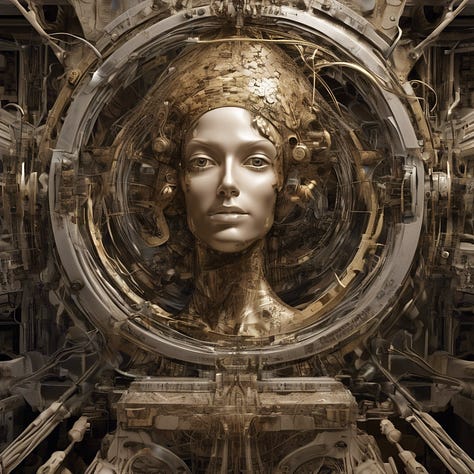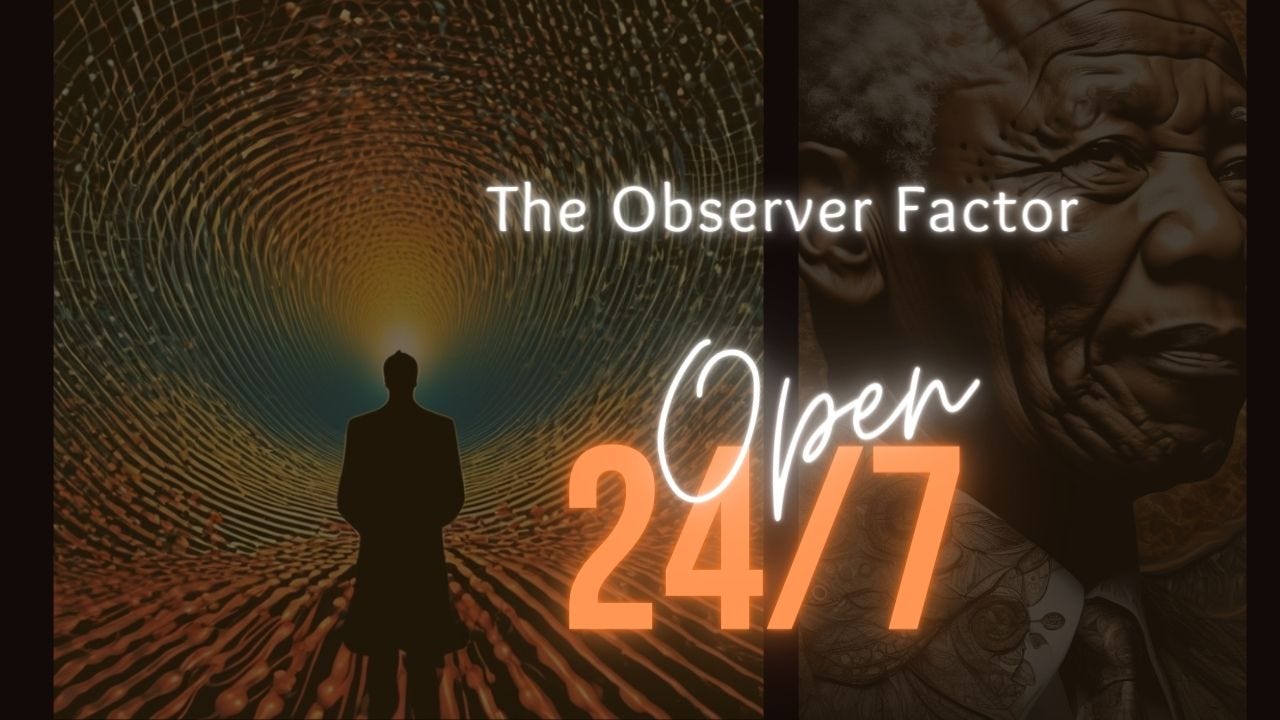Our past is fixed and our future is up to us.
So we've been taught since the moment our tiny little feet became firmly planted on this Earth. But what if it's not true? What if time is malleable, not just in the future, but in both directions?
This story is about something called the Mandela Effect and how physics provides real evidence that we can change the past.
The Mandela Effect: Hopping timelines and parallel universes.
Many people remember the Berenstein Bears, although if you're like me, you don’t remember much about the actual books (and if you’re as old as me, you missed the cartoon altogether). Nevertheless, I still remember the Berenstein Bears. Except, there were no Berenstein Bears. The book was actually called the Berenstain Bears. With an 'ai' not an 'ei.' (Don’t believe me? Google it - I’ll wait.) If you remember the Berenstein Bears (like me), you've just experienced the Mandela Effect.
The Berenstain Bears are a relatively small example of the Mandela Effect, but the phenomenon is based on a much bigger memory inconsistency that has many people swearing the history books are wrong. History tells us that Nelson Mandela was released from prison in 1990, served as President of South Africa, and died in 2013. However, there are many people who remember an alternate timeline where Nelson Mandela died in prison in 1991.
The simplest explanation for the Mandela effect is that people are just misremembering. Yet, some who remember Nelson Mandela dying in prison also remember newspaper headlines and seeing funeral parades on T.V. (if you are old enough to remember when Princess Diana died, I imagine it would be like that). And there are lots of examples of Mandela Effects, big and small (check out this article for a list of common Mandela examples – there are also plenty of YouTube videos and online articles to explore).
So, is the Mandela Effect merely a case of misremembering? Maybe. But, contemplating the Mandela Effect brings up concepts in physics that are weird and interesting, even if we don’t remember the movie Shazaam starring Sinbad (hint: it doesn’t exist in the current timeline).
Let’s start with the most common alternative explanation that has been proposed for the Mandela Effect, which is that our timeline has shifted into a parallel reality. For proponents of this theory, we were cruising along in our normal, standard 'reality', and then *POOF* we suddenly shifted to a parallel universe (this one), where bears are spelled with an 'ai' and chartreuse is a greenish color (I would absolutely swear chartreuse is a shade of red, even now!).
According to the parallel universe explanation, some people still remember the old timeline, which is why we have Mandela Effects. As strange as it sounds, parallel universes are a very real possibility in the world of physics, even if current models don’t allow for remembering alternate timelines (see “Could quantum mechanics be responsible for the Mandela effect?”). The emerging field of quantum computing may even depend on the existence of parallel universes (see 20 Mind-Boggling Facts About Quantum Computing Everyone Should Read)! And that’s pretty darn cool!
Another idea that has been proposed for explaining the Mandela Effect will stretch your imagination even further. According to this alternate theory, we create our reality, not just for events that move forward in time, but also events that happened in the past!! (for example, see thisYouTube video) In other words, time doesn’t just flow forward, it flows backward, too!
So, could we be changing our past? These kinds of questions may be impossible to answer, but the Mandela Effect is a fun way to introduce very real, very bizarre concepts in physics that are being studied by mainstream scientists. Ultimately, these ideas are challenging our understanding of time, space, consciousness, and the very nature of reality itself. Let’s talk about time, consciousness, and the physics of changing the past!
Is time real?
Surely time flows in one direction, right? After all, the passage of time is a basic part of our human experience, and we are all taught that we can’t change the past. However, at least some of the people reading this are probably familiar with or may even be comfortable with the idea that time is an illusion, despite difficulties that the “time does not exist” concept presents for our physical brains.
It turns out that physicists have also wrestled with this concept (for many, many decades), but for different reasons. A really cool Quanta Magazine article called “A Debate Over the Physics of Time” sums up the conundrum (for physicists):
“The laws that underlie these theories [the general theory of relativity, and the Standard Model of particle physics] are time-symmetric — that is, the physics they describe is the same, regardless of whether the variable called “time” increases or decreases. Moreover, they say nothing at all about the point we call “now” — a special moment (or so it appears) for us, but seemingly undefined when we talk about the universe at large. The resulting timeless cosmos is sometimes called a “block universe” — a static block of space-time in which any flow of time, or passage through it, must presumably be a mental construct or other illusion.”
So, while the concept of a block universe (and static space-time) is a controversial one, it’s fundamental to our current understanding of physics. (The bit about time being a mental construct is pretty interesting, innit?)
The Observer Effect: Is consciousness fundamental to quantum physics?
The idea that consciousness is a fundamental force like gravity or electromagnetism may seem like a new age topic, but it’s one that has been central to spiritual philosophies for centuries, and even mainstream physicists have seriously considered the idea since the early days of quantum theory (See this American Association for the Advancement of Science post: “Quantum mechanics and the consciousness connection”).
In fact, early physicists recognized that a seemingly fundamental aspect of quantum theory is that the observer plays a role in the outcome of measurements of quantum behavior, and scientists have been exploring the “observer effect” ever since. The observer effect is based on the idea that the energy state of a quantum particle (such as a photon or an electron) depends on the measurement of that state (the observation).
Physicists have been testing the observer effect for decades using variations of the famous “double slit” experiment. These experiments illustrate how photons or electrons (and even molecules) shift from existing in an undefined state with wavelike properties to having defined properties of a particle, only when they are observed.
The results from these experiments are profoundly weird (as described in this YouTube video, “The Quantum Experiment that Broke Reality | Space Time”), and have made physicists uneasy since the beginning of quantum theory. This PBS Nova article summarizes the early thinking of some of the pioneers of quantum theory:
“But ask Niels Bohr and he would argue that particles don't have finite positions or momentum until they are measured by an observer, at which point the act of measurement itself forces the particle to "take a stand" and choose a state. Pascual Jordan, one of the fathers of quantum mechanics, put it this way: ‘Observations not only disturb what is to be measured, they produce it...we compel (the particle) to assume a definite position.’’”
While many physicists assume the need for an observer is a misunderstanding of reality or an artifact of using scientific instruments to measure quantum particles, increasingly sophisticated variations of the famous double slit experiment suggest that the state of a quantum particle is truly dependent on the observer (not just the measurement – did you watch that last YouTube clip?).
And as we’ll talk about next, efforts to push these experiments farther have uncovered even more bizarre results that are challenging everything we think we know about reality!
Is it possible to change the past?
This part of our journey is based on experimental results that are even weirder for physicists, and much, much more interesting for spiritually minded folks! Enter the so-called “delayed-choice quantum eraser” experiment, which is a variation of the double-slit experiment designed to test what happens if we make our observation after the quantum particle has passed through the slit. I highly recommend watching “How the Quantum Eraser Rewrites the Past” on YouTube,which provides a fantastic overview of the quantum eraser experiment and its implications for us non-physicists.
The implications of the quantum eraser experiment are summarized in this Wikipedia article :
“The delayed-choice quantum eraser experiment investigates a paradox. If a photon manifests itself as though it had come by a single path to the detector, then "common sense" (which Wheeler and others challenge) says that it must have entered the double-slit device as a particle. If a photon manifests itself as though it had come by two indistinguishable paths, then it must have entered the double-slit device as a wave. If the experimental apparatus is changed while the photon is in mid‑flight, then the photon should reverse its original "decision" as to whether to be a wave or a particle. Wheeler pointed out that when these assumptions are applied to a device of interstellar dimensions, a last-minute decision made on Earth on how to observe a photon could alter a decision made millions or even billions of years ago.”
Much to the discomfort of many physicists, delayed choice quantum eraser experiments strongly suggest that the observer really can change the state of a quantum particle in the past! So, while changing the past seems like a topic for science fiction, this isn’t just a discussion for spiritual groups or Mandela Effects…mainstream scientists are seriously discussing how our observations determine the nature of reality, not just right now or in the future, but for “events that have already occurred!”
For the classic Batman fans out there...ZOWIE!
Metaphysical ramblings on quantum weirdness and the nature of time
The concept that we live in the now is thousands of years old, and the nature of time is a common topic in spirituality communities. It seems that time is necessary for our 3D reality, and many believe there are people who can peek into the future to get a glimpse of what might be in store for humanity; interestingly these predictions are often described as probabilities, which is the kind of language physicists use to explain how photons and electrons collapse from a wave into a particle, but at a macroscopic level.
The idea that consciousness is a fundamental force like gravity or electromagnetism has also been central to spiritual philosophies for centuries. But what about the idea that we can change the past? (The idea of creating our past is described in this Youtube video - jump to 29:30).
Altering the past usually isn’t part of the discussion of how we use consciousness to manifest reality (arguments involving hopped up ‘85 DeLoreans don’t count), even in spiritual communities. Maybe it’s too weird, even for those of us who are perfectly comfortable dropping the "para" from paranormal. After all, time moving forward is central to our experience, and we’ve all been taught that we can’t change the past.
Yet, if we can cozy up to the idea that time doesn’t exist, and that we are creating our reality, then should creating the past be off limits?And if the past can be changed (not just the future), what does that mean (for us, for our understanding of reality, for…everything)?
These concepts are by no means easy to wrap one’s brain around, and the idea that we’re creating our past leads to many more questions than answers. But, aren’t all great mysteries like that? Which is why it’s so fun to think about!
Some final thoughts & questions
Despite many questions (or because of them?), the idea that we are creating both our future and our past resonates on some level (for me), even though my limited 3D physical brain can’t even begin to make sense of it all. Extending these ideas a little further, here are some questions that pop into my mind, which are framed from the perspective that we are spiritual beings who choose the human experience to learn and grow:
• What if our collective consciousness is the observer and our reality is the outcome of collapsing a wavelike probabilistic future into a particle-like now that we can taste and touch on a macroscopic level? (I’m not the first to have these thoughts)
• Does our soul growth depend on constant exploration of timelines, dead ends of a sort where our collective effort might cause a negative impact, but we then have the power to reshape our entire past to continue our evolution?
• Does soul growth involve continually adjusting our entire timeline as part of the evolutionary process (including past events)?
• If we create a new, more evolved timeline, does the old timeline exist in parallel or is merely part of our total experiences that helped us to evolve to where we are today (on the brink of something BIG! We all feel it!)?
• Could alterations to past timelines be what causes "splits" or "shifts" in evolution (and subsequent Mandela effects), like the one we seem to be moving towards in our current now (yeah, I said that)?
P.S. I’m totally onboard with the idea that time is an illusion, but I still struggle mightily to comprehend what that means. One way of grappling with the concept of no-time is by comparing reality to a DVD. When we watch a movie on a DVD, we see a series of events that give the impression of linear time. However, all the information for the movie is stored within grooves that are etched into a polymer disc. Therefore, time is not required for the entire movie to exist within the DVD in an eternal state of now. Yet, we cannot extract information from the DVD in a meaningful way by using our physical senses alone. The information contained within the DVD (reality) only becomes a movie (perceived reality) when data is extracted from the grooves to produce an image and a rotational mechanism spins the disc so that individual images can be stitched together to give the appearance of linear time (plus actual technical stuff that isn’t necessary for the analogy). And if you’re wondering, extending the DVD analogy to the idea that we are creating our reality (in forward or reverse) leads down time-consuming rabbit holes (trust me on this).
P.P.S. I will point out that most of this post was the result of one stream-of-consciousness jam session, which I believe was a higher source giving me the lowdown on what’s what, but could have just as easily been sleep deprivation. Plus, being a 3D human, I felt compelled to edit my original draft and extend my original thoughts, which is my way of saying “blame the receiver (my puny 3D brain) for any plot holes, not the sender (God/Source/Higher Self).” Plot holes or not, I hope these questions at least get you thinking about this interesting topic, and maybe some of you out there might even be having your own streams-of-consciousness jam sessions to communicate whatever it is that the Source wants us to know because of words I wrote above!






